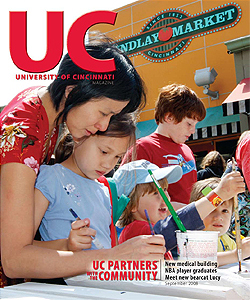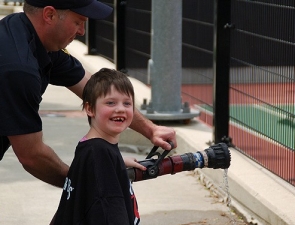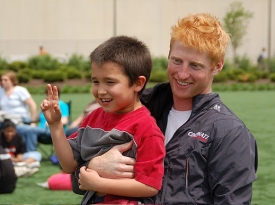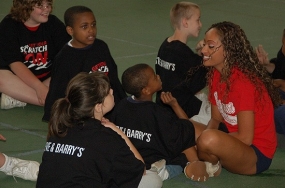by John Bach
No scoreboard. No fans. No stats.
For student-athletes at the University of Cincinnati, often the most meaningful performance of the year takes place off the court, away from the field and miles from the nearest track or golf course. For Bearcat players who regularly volunteer in the community, it is a chance to make a difference in the lives of people, mostly youth, throughout the city.
Whether hosting Special Olympians on campus, handing out care packages to the homeless on the streets or buying Christmas presents for area poor families, UC jocks are growing accustomed to thinking of others and putting those thoughts into action. They brainstorm outreach ideas, organize activities and even raise their own funds. Then they get to work.
"This is definitely an opportunity to give back," says senior Evan Sanford, Bus '08, a relief pitcher on the UC baseball team. For him, community projects allow athletes to team up in a whole new way, whether that's mentoring children or putting on a clothing drive for the needy. The scholar right-hander says he and teammates never tire of the way "kids look up to you and value what you have to say just because you are a Bearcat."
The outreach covers every sport. UC football players, for example, drop by area elementary schools to play with youngsters at recess. And what fourth-grader wouldn't want 314-pound tackle Kalil El Amin on his kickball team? The athletes have fun with the children, but they also read to them, interact with them in the classroom and stress the importance of education.
Soccer players trade uniforms for aprons and whip up meals at the Ronald McDonald House. Stepping off the field and into the kitchen is their way of reaching out to families whose children are undergoing serious medical procedures at Cincinnati Children's Hospital.
Bearcat golfers help underprivileged children pick out new school clothes and help raise funds for the Assistance League of Greater Cincinnati's Operation School Bell program. UC golf coach Janet Carl says volunteering in the community helps her athletes understand, even long after they leave campus, that they'll accomplish much more in life when they work together to solve problems.

 Issue Archive
Issue Archive

